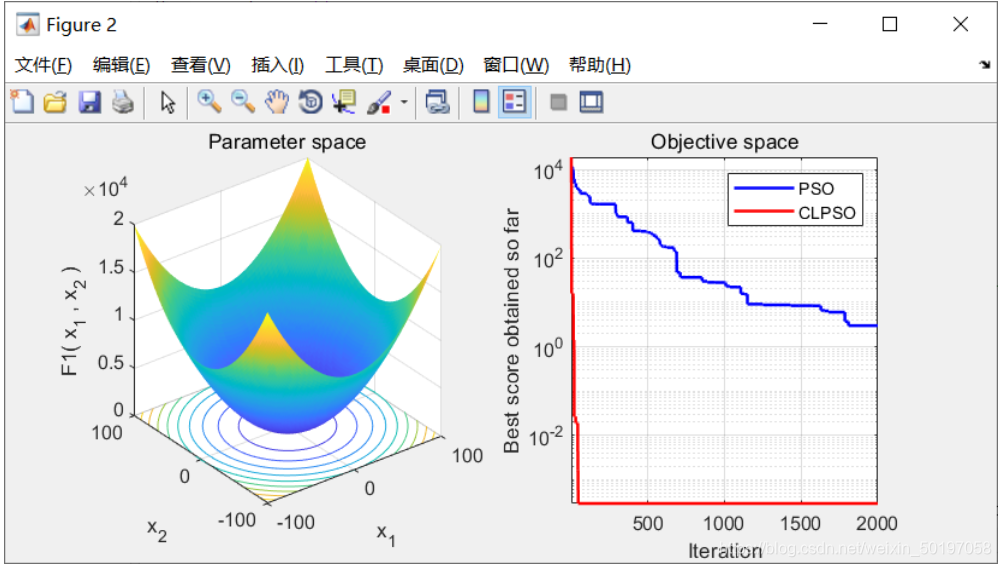1 模型见这里
简介。
2 部分代码
function [gbest,gbestval,fitcount]= CLPSO_new_func(fhd,Max_Gen,Max_FES,Particle_Number,Dimension,VRmin,VRmax,varargin)
%[gbest,gbestval,fitcount]= CLPSO_new_func('f8',3500,200000,30,30,-5.12,5.12)
rand('state',sum(100*clock));
me=Max_Gen;
ps=Particle_Number;
D=Dimension;
cc=[1 1]; %acceleration constants
t=0:1/(ps-1):1;t=5.*t;
Pc=0.0+(0.5-0.0).*(exp(t)-exp(t(1)))./(exp(t(ps))-exp(t(1)));
% Pc=0.5.*ones(1,ps);
m=0.*ones(ps,1);
iwt=0.9-(1:me)*(0.7/me);
% iwt=0.729-(1:me)*(0.0/me);
cc=[1.49445 1.49445];
if length(VRmin)==1
VRmin=repmat(VRmin,1,D);
VRmax=repmat(VRmax,1,D);
end
mv=0.2*(VRmax-VRmin);
VRmin=repmat(VRmin,ps,1);
VRmax=repmat(VRmax,ps,1);
Vmin=repmat(-mv,ps,1);
Vmax=-Vmin;
pos=VRmin+(VRmax-VRmin).*rand(ps,D);
for i=1:ps;
e(i,1)=feval(fhd,pos(i,:),varargin{:});
end
fitcount=ps;
vel=Vmin+2.*Vmax.*rand(ps,D);%initialize the velocity of the particles
pbest=pos;
pbestval=e; %initialize the pbest and the pbest's fitness value
[gbestval,gbestid]=min(pbestval);
gbest=pbest(gbestid,:);%initialize the gbest and the gbest's fitness value
gbestrep=repmat(gbest,ps,1);
stay_num=zeros(ps,1);
ai=zeros(ps,D);
f_pbest=1:ps;f_pbest=repmat(f_pbest',1,D);
for k=1:ps
ar=randperm(D);
ai(k,ar(1:m(k)))=1;
fi1=ceil(ps*rand(1,D));
fi2=ceil(ps*rand(1,D));
fi=(pbestval(fi1)<pbestval(fi2))'.*fi1+(pbestval(fi1)>=pbestval(fi2))'.*fi2;
bi=ceil(rand(1,D)-1+Pc(k));
if bi==zeros(1,D),rc=randperm(D);bi(rc(1))=1;end
f_pbest(k,:)=bi.*fi+(1-bi).*f_pbest(k,:);
end
stop_num=0;
i=1;
while i<=me&fitcount<=Max_FES
i=i+1;
for k=1:ps
if stay_num(k)>=5
% if round(i/10)==i/10%|stay_num(k)>=5
stay_num(k)=0;
ai(k,:)=zeros(1,D);
f_pbest(k,:)=k.*ones(1,D);
ar=randperm(D);
ai(k,ar(1:m(k)))=1;
fi1=ceil(ps*rand(1,D));
fi2=ceil(ps*rand(1,D));
fi=(pbestval(fi1)<pbestval(fi2))'.*fi1+(pbestval(fi1)>=pbestval(fi2))'.*fi2;
bi=ceil(rand(1,D)-1+Pc(k));
if bi==zeros(1,D),rc=randperm(D);bi(rc(1))=1;end
f_pbest(k,:)=bi.*fi+(1-bi).*f_pbest(k,:);
end
for dimcnt=1:D
pbest_f(k,dimcnt)=pbest(f_pbest(k,dimcnt),dimcnt);
end
aa(k,:)=cc(1).*(1-ai(k,:)).*rand(1,D).*(pbest_f(k,:)-pos(k,:))+cc(2).*ai(k,:).*rand(1,D).*(gbestrep(k,:)-pos(k,:));%~~~~~~~~~~~~~~~~~~~~~~
vel(k,:)=iwt(i).*vel(k,:)+aa(k,:);
vel(k,:)=(vel(k,:)>mv).*mv+(vel(k,:)<=mv).*vel(k,:);
vel(k,:)=(vel(k,:)<(-mv)).*(-mv)+(vel(k,:)>=(-mv)).*vel(k,:);
pos(k,:)=pos(k,:)+vel(k,:);
if (sum(pos(k,:)>VRmax(k,:))+sum(pos(k,:)<VRmin(k,:)))==0;
e(k,1)=feval(fhd,pos(k,:),varargin{:});
fitcount=fitcount+1;
tmp=(pbestval(k)<=e(k));
if tmp==1
stay_num(k)=stay_num(k)+1;
end
temp=repmat(tmp,1,D);
pbest(k,:)=temp.*pbest(k,:)+(1-temp).*pos(k,:);
pbestval(k)=tmp.*pbestval(k)+(1-tmp).*e(k);%update the pbest
if pbestval(k)<gbestval
gbest=pbest(k,:);
gbestval=pbestval(k);
gbestrep=repmat(gbest,ps,1);%update the gbest
end
end
end
% if round(i/100)==i/100
% plot(pos(:,D-1),pos(:,D),'b*');hold on;
% for k=1:floor(D/2)
% plot(gbest(:,2*k-1),gbest(:,2*k),'r*');
% end
% hold off
% title(['PSO: ',num2str(i),' generations, Gbestval=',num2str(gbestval)]);
% axis([VRmin(1,D-1),VRmax(1,D-1),VRmin(1,D),VRmax(1,D)])
% drawnow
% end
if fitcount>=Max_FES
break;
end
if (i==me)&(fitcount<Max_FES)
i=i-1;
end
end
gbestval
3 仿真结果?

4 参考文献
[1] J.J. Liang, A.K. Qin, P.N. Suganthan, S. Baskar, Comprehensive learning particle swarm optimizer for global optimization of multimodal functions, IEEE Trans. Evol. Comput. 10 (3) (2006) 281–295.